Episodes
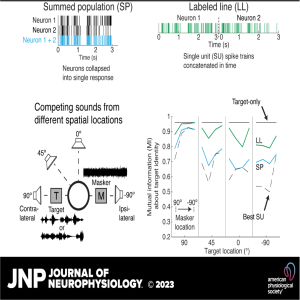
Wednesday Dec 13, 2023
Wednesday Dec 13, 2023
In this podcast, author Jian Carlo Nocon (Boston University) discusses the recently published research titled "A robust and compact population code for competing sounds in auditory cortex."
NEW & NOTEWORTHY
Little is known about how populations of neurons within cortical circuits encode sensory stimuli in the presence of competing stimuli at other spatial locations. Here, the authors investigate this problem in auditory cortex using a recently proposed information-theoretic approach. They found a small subset of neurons nearly maximizes information about target sounds in the presence of competing maskers, approaching information levels for isolated stimuli, and provides a noise-robust code for sounds in a complex auditory scene.
Article Citation:
A robust and compact population code for competing sounds in auditory cortex
Jian Carlo Nocon, Jake Witter, Howard Gritton, Xue Han, Conor Houghton, and Kamal Sen
Journal of Neurophysiology 2023 130:3, 775-787

Friday Nov 17, 2023
Friday Nov 17, 2023
In this podcast coauthor Daniel Free of Brigham Young University talks about the recently published article titled “Essential tremor accentuates the pattern of tremor-band coherence between upper limb muscles.”
NEW & NOTEWORTHY This research characterized the relationships in tremor-band activity between the 15 major superficial upper limb muscles of persons with essential tremor by quantifying the proportion of shared activity (coherence) in the tremor band and by characterizing phase differences between these muscles during various tasks. From the authors observations, they conclude that tremor enhances the coherence between muscle pairs throughout the upper limb in a pattern that reflects functional relationship between them.
Article Citation:
Essential tremor accentuates the pattern of tremor-band coherence between upper limb muscles
Daniel B. Free, Ian Syndergaard, Adam C. Pigg, Silvia Muceli, Johanna Thompson-Westra, Karin Mente, Carine W. Maurer, Dietrich Haubenberger, Mark Hallett, Dario Farina, and Steven K. Charles
Journal of Neurophysiology 2023 129:3, 524-540
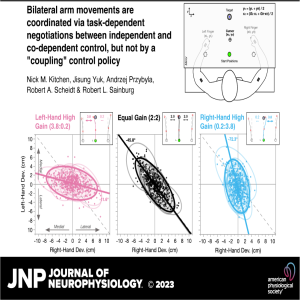
Friday Nov 03, 2023
Friday Nov 03, 2023
In this podcast Nick Kitchen and Jisung Yuk of Pennsylvania State University discuss the recently published manuscript “Bilateral arm movements are coordinated via task-dependent negotiations between independent and codependent control, but not by a “coupling” control policy.”
NEW & NOTEWORTHY Minimization of performance and control costs and efferent coupling between bilaterally homologous muscle groups have been separately hypothesized to describe patterns of bimanual coordination. Here, we address whether the mechanisms mediating independent and codependent control between limbs can be weighted for successful task performance. Using bilaterally asymmetric visuomotor gain perturbations, we show bimanual coordination can be characterized as a negotiation along a spectrum between extremes of independent and codependent control, but not efferent control coupling.
Article Citation:
Nick M. Kitchen, Jisung Yuk, Andrzej Przybyla, Robert A. Scheidt, and Robert L. Sainburg
Journal of Neurophysiology
2023 130:3, 497-515
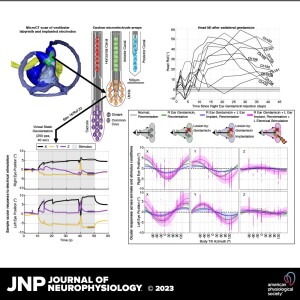
Monday Oct 30, 2023
Monday Oct 30, 2023
Margaret Chow and Celia Fernandez Brillet of Johns Hopkins School of Medicine discuss the recently published manuscript titled "Binocular 3-D otolith-ocular reflexes: responses of chinchillas to natural and prosthetic stimulation after ototoxic injury and vestibular implantation."
NEW & NOTEWORTHY Previous studies to expand the scope of prosthetic stimulation of the otolith end organs showed that selective stimulation of the utricle and saccule is possible. This article further defines those possibilities by characterizing a diseased animal model and subsequently studying its responses to electrical stimulation alone and in combination with mechanical motion. We show that we can partially restore responses to tilt and translation in animals with unilateral gentamicin ototoxic injury and contralateral surgical disruption.
Article Citation:
Margaret R. Chow, Celia Fernandez Brillet, Kristin N. Hageman, Dale C. Roberts, Andrianna I. Ayiotis, Razi M. Haque, and Charles C. Della Santina
Journal of Neurophysiology 2023 129:5, 1157-1176
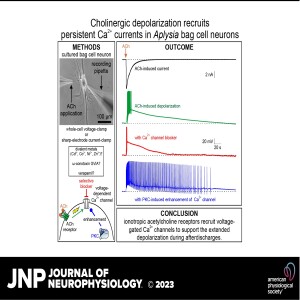
Monday Oct 16, 2023
JNP Micro Podcasts: Acetylcholine receptor and persistent current
Monday Oct 16, 2023
Monday Oct 16, 2023
In this paper first author Kelly H. Lee, and Alex Prosserman, an expert in the field discuss the recently published article titled “Cholinergic depolarization recruits a persistent Ca2+ current in Aplysia bag cell neurons.”
NEW & NOTEWORTHY Ionotropic acetylcholine receptors mediate brief synaptic communication, including in bag cell neurons of the sea snail Aplysia. However, this study demonstrates that cholinergic depolarization can open a voltage-gated persistent Ca2+ current, which extends the bag cell neuron response to acetylcholine. Bursting in these neuroendocrine cells results in hormone release and egg laying. Thus, this emphasizes the role of ionotropic signaling in reaching a depolarized level to engage Ca2+ influx and perpetuating the activity necessary for behavior.
Article Citation:
Cholinergic depolarization recruits a persistent Ca2+ current in Aplysia bag cell neurons
Kelly H. Lee, David E. Wassef, Eammon K. MacNeil, and Neil S. Magoski
Journal of Neurophysiology 2023 129:5, 1045-1060

Tuesday Oct 10, 2023
Tuesday Oct 10, 2023
In this podcast Dr. Elijah Haynes and Dr. Jennifer Jakobi of the University of British Columbia Okanagan, and Dr. Jayne Kalmar of the Wilfrid Laurier University discuss the recently published Systematic Review titled “A systematic review of how cannabinoids affect motoneuron output.” This scoping review involved the synthesis of evidence from literature published before August 2022 about the effects of cannabinoids on quantifiable measures of motoneuron output. It contributes to understanding the effects of endocannabinoids on synaptic integration at the motoneuron and modulation of motor output.
Article Citation:
A systematic review of how cannabinoids affect motoneuron output
Elijah M. K. Haynes, Jayne M. Kalmar, Mathew Vis-Dunbar, Kathryn M. Crosby, Angitha Mriduraj, and Jennifer M. Jakobi
Journal of Neurophysiology
2023 130:2, 247-263
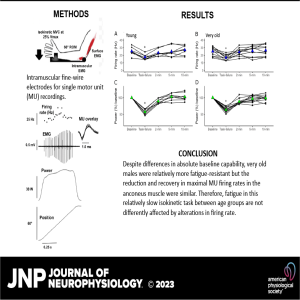
Friday Sep 15, 2023
JNP Micro Podcasts ”Four Questions”: Alexander M. Zero
Friday Sep 15, 2023
Friday Sep 15, 2023
In this podcast co lead author Alexander M. Zero of The University of Western Ontario discusses the recently published research titled "Motor unit firing rates in young and very old adult males during an isokinetic fatiguing task and short-term recovery in the anconeus muscle."
NEW & NOTEWORTHY Maximal motor unit firing rates were recorded during an isokinetic fatiguing protocol and short-term recovery in young and very old adult males. Prior studies were limited to isometric fatiguing tasks. Despite the old being ∼37% weaker and less fatigable, anconeus rates during elbow extension declined with fatigue and recovered similarly to young males. Therefore, it is unlikely that greater fatigue resistance of very old males during isokinetic contractions is related to differences in motor unit rates.
Article Citation:
Journal of Neurophysiology 2023 130:1, 179-188
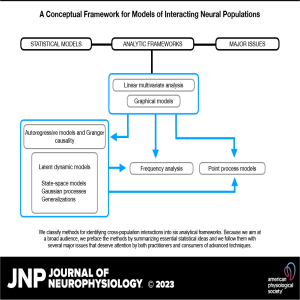
Friday Sep 08, 2023
JNP Micro Podcasts ”Four Questions”: Robert Kass
Friday Sep 08, 2023
Friday Sep 08, 2023
In this podcast Robert E. Kass of Carnegie Mellon University discusses the recently published review article titled "Identification of interacting neural populations: methods and statistical considerations."
Abstract: As improved recording technologies have created new opportunities for neurophysiological investigation, emphasis has shifted from individual neurons to multiple populations that form circuits, and it has become important to provide evidence of cross-population coordinated activity. We review various methods for doing so, placing them in six major categories while avoiding technical descriptions and instead focusing on high-level motivations and concerns. Our aim is to indicate what the methods can achieve and the circumstances under which they are likely to succeed. Toward this end, we include a discussion of four cross-cutting issues: the definition of neural populations, trial-to-trial variability and Poisson-like noise, time-varying dynamics, and causality.
Article Citation:
Journal of Neurophysiology 2023 130:3, 475-496
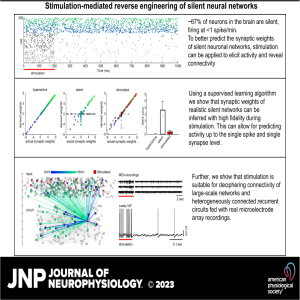
Friday Sep 01, 2023
Friday Sep 01, 2023
In this podcast Xiaoxuan Ren, Ilhan Bok, Adam Vareberg, and Prof. Aviad Hai of the University of Wisconsin-Madison discuss their recently published Innovative Methodology titled "Stimulation-mediated reverse engineering of silent neural networks."
NEW & NOTEWORTHY We introduce a new concept for reverse engineering silent neuronal networks using a supervised learning algorithm combined with stimulation. We quantify the performance of the algorithm and the precision of deriving synaptic weights in inhibitory and excitatory subpopulations. We then show that stimulation enables deciphering connectivity of heterogeneous circuits fed with real electrode array recordings, which could extend in the future to deciphering connectivity in broad biological and artificial neural networks.
Article Citation:
Journal of Neurophysiology 2023 129:6, 1505-1514
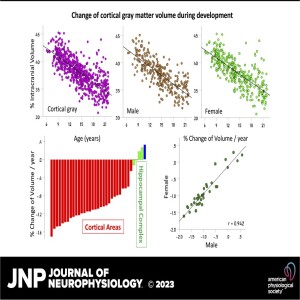
Friday Aug 25, 2023
JNP Micro Podcasts ”Four Questions”: Apostolos P. Georgopoulos
Friday Aug 25, 2023
Friday Aug 25, 2023
In our latest podcast Prof. Apostolos P. Georgopoulos discusses recently published Short Report titled "Changes of cortical gray matter volume during development: a Human Connectome Project study."
NEW & NOTEWORTHY We report mixed effects of age on cortical gray matter volume during development in a large sample of 649 participants studied in an identical manner (6–21 yr old, 299 males, 350 females). Volumes of 30/35 cortical areas decreased with age, temporal pole increased, and pericalcarine and hippocampal cortex (hippocampus, parahippocampal, and entorhinal) did not change. These findings were very similar in both sexes and provide a solid base for assessing region-specific cortical changes during development.
Article Citation:
Journal of Neurophysiology 2023 130:1, 117-122

